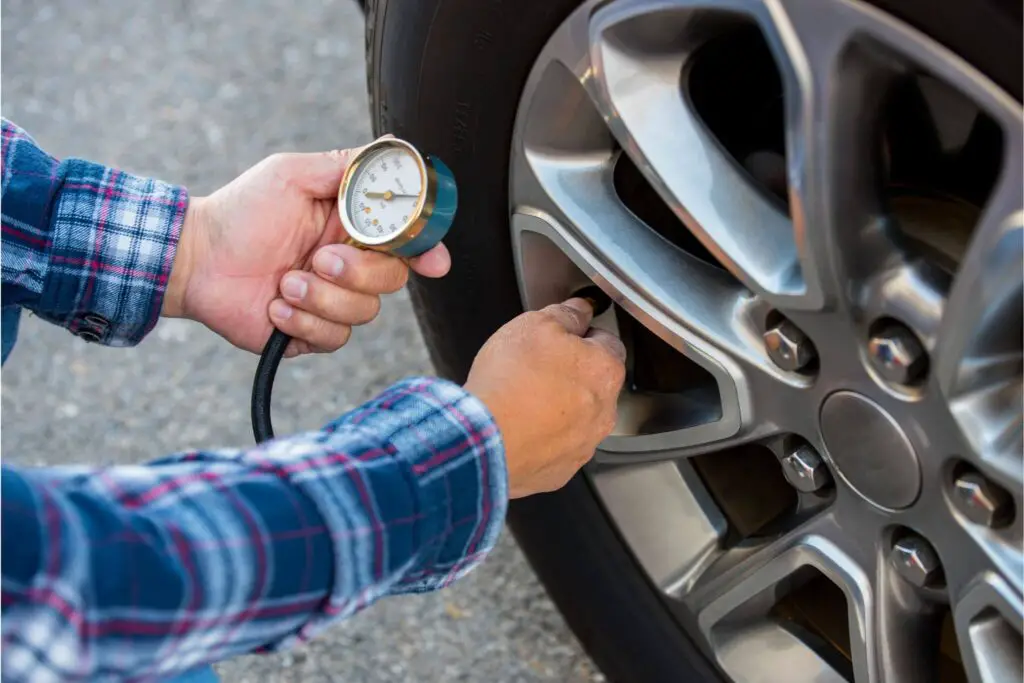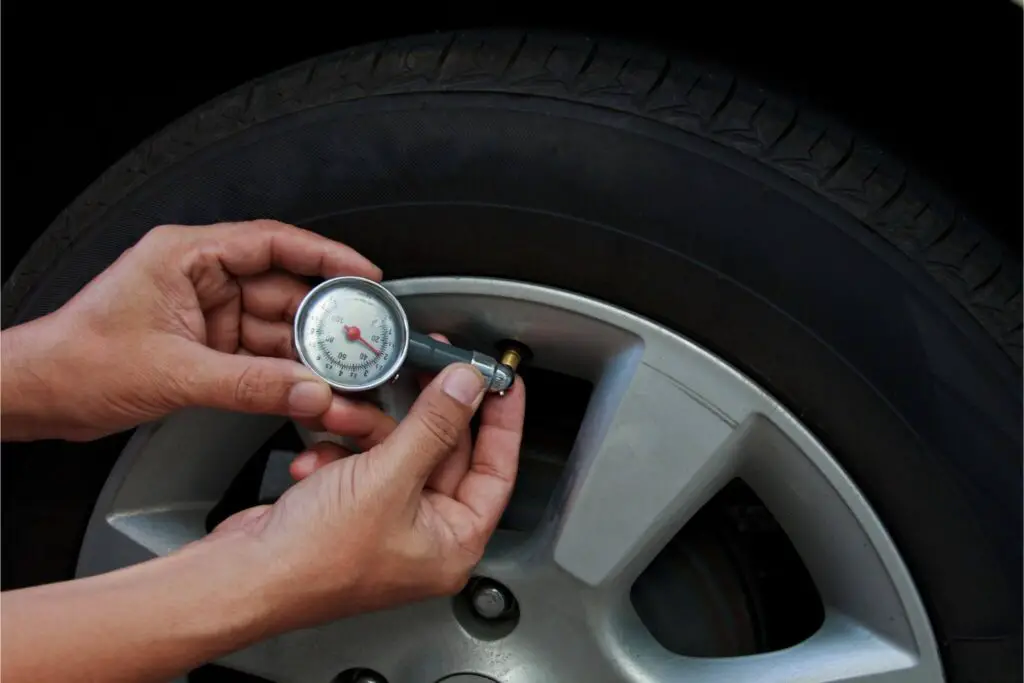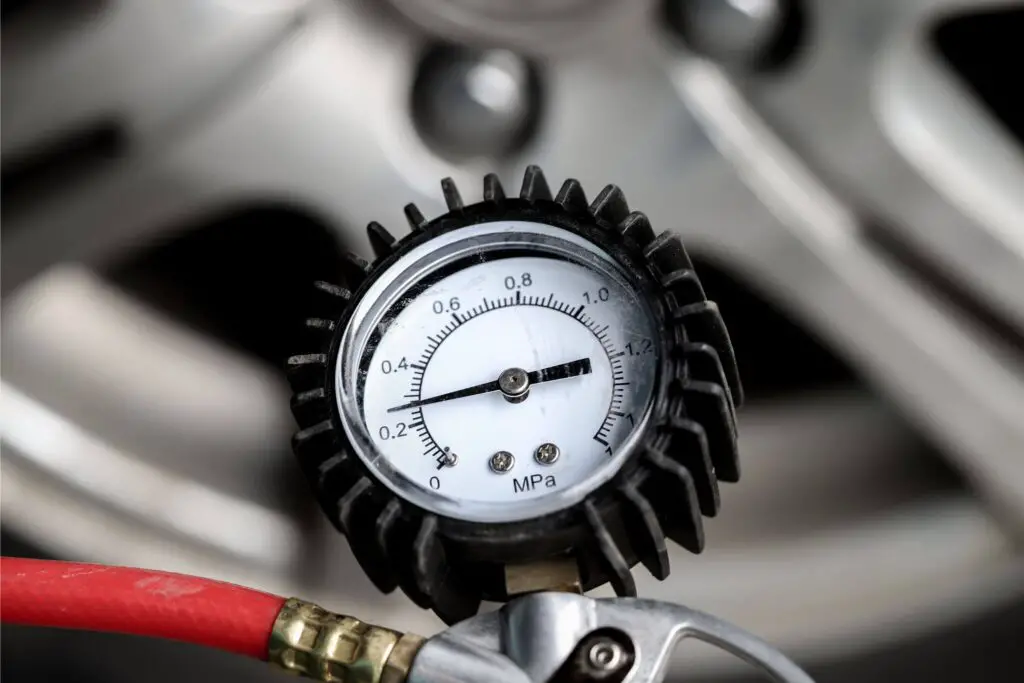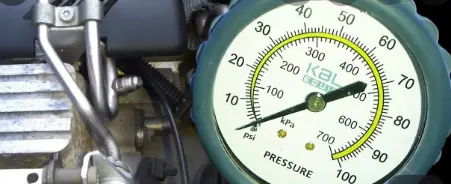Knowing your vehicle’s fuel pressure is absolutely important in determining whether your fuel pump is in order or not.
It also enables you to know what may be the cause of your car stalling or failing to start after two or more repeated attempts at kick-starting it, particularly in the mornings when the engine has taken the time to cool throughout the night.
But, how do you check your fuel pressure, if there is no fuel pressure pump at hand?
Can You Check Fuel Pressure With A Tire Gauge
So, Can you check fuel pressure with a tire gauge? Yes, you can check your fuel pressure with a tire gauge, but mainly in emergency situations and only for low or high pressures too.
Thereafter, you are advised to throw away any such tire pressure gauges used in this fuel pressure testing immediately afterward.
It is common knowledge that every car is equipped with a fuel pressure testing part, which is commonly located beside the hood of the car’s fuel injectors.
Air is known to be highly compressible, while gasoline, on the other hand, is not anything as near compressible as air. In addition, fuel may also leak where air and water will not.
Furthermore, air pressure gauges are not meant to have solvents in them and gasoline is full of solvents. In essence, though you can somehow check fuel pressure with the use of an air gauge, the endeavor is at best very risky to undertake.
Can you test a fuel pump out of the tank?
Yes, you can test a fuel pump out of the tank, but that should be done before its installation in the system and with a multimeter.
However, while doing this, you should observe the continuity of the connector and motor windings as you use it. If the pump is working perfectly, the resistance of the windings should be between 2 and about 10 Ohms.
How does the fuel pressure gauge regulator work?
Most notably, the fuel pressure gauge regulator oversees the regulation of all fuel pressures against the air boost or pressure.
It also allows the fuel injector to keep the ratio between the boost and the fuel. The fuel pressure regulator has a kind of diaphragm that is known to control the bye-pass valve, which is also known as the ball seat too.
(Read Also: Will Jeep Wheels Fit Toyota Tundra?)
The FPR is mainly used in cars that are equipped with the Electronic Fuel Injection( EFI). The FPR also serves to maintain the fuel pressure to stay constant in all engine working conditions. Similarly, it sprays less fuel into the engine if it is idling.
In fact, the FPR does anything that will determine how well your vehicle gets fuel supplied to it at all times. For a fully loaded engine, the fuel injector will spray more fuel into the engine to facilitate increased combustion in its cavity.
This means that the fuel pressure in the delivery pipe will basically remain the same. Conversely, whenever the engine is turned off, the fuel pump stops working too and its springs will press on the diaphragm and also the valve as well.
As a result of this, the valve will be closed and the check valve in the fuel pump will equally close too in response. If the FPR is faulty, the fuel pressure cannot be maintained and the engine will be difficult to kick start, and may also iddle unstably sometimes as well. In some rare cases, the engine power may also reduce in response to this.
Is the air pressure gauge the same as the water pressure gauge?


Yes, basically they are. Any oil, water and air pressures can be evaluated using the same pressure gauge, as long as the pressure to be measured does not exceed the capacity of the gauge or meter.
You can also measure fuel pressure using the same water or air gauge. Although whenever you use it for measuring fuel pressure, you are required to promptly throw the pump away.
Whatever differences there may be between these gauges, it is purely attributable to differences in the solvent contents of the fluids. So, yes, the water pressure gauge is the same as an air pressure gauge.
Trending searches
- Will Snow Chains Damage Rims?Find Out NOw
- How To Pop A Tire Back On The Rim With Fire Like A Pro
- How To Fix ATV Tire Leaking Around The Rim With Steps
What causes low fuel pressure?
Low fuel pressure has several different causes in vehicles. One of the major ones is a faulty or malfunctioning fuel pump.
Another is when you happen to have a bad or damaged fuse in your pump. Finally, the low power supply can also manifest as low fuel pressure in vehicles too.
When there is a low power supply in the fuel pump, you are bound to have a weak or drained battery behind it.
How do you check the pressure on a 350z?
There are several techniques that can be used in checking the pressure on a 35 oz.
The first is the aneroid gauge, which measures pressure using a sort of metallic pressure responsive element that takes different forms, but actually works on the same principle.
This is a kind of flexing elasticity under pressure applications differential. Secondly, is the Bourdon tube, which is a kind of flattened thin wall closed-end tube that is formed into a C-shape or helix.
Whenever pressure is applied to the inside of this tube, the oval cross-section of the tube will become sort of circular or will straighten out the tube, which will, in turn, regain its shape when the pressure is relieved.
These alternate changes in shape are communicated to a pointer which is read against a graduated scale.
Finally, there is the diaphragm, which is a pressure gauge that uses the deflection of a flexible membrane. As the pressure builds up, the diaphragm flexes in response to it, which can also be measured against a graduated scale too.
Will tire pressure gauge work as a fuel pressure gauge?


Yes, a tire pressure gauge can conveniently work as a fuel pressure gauge too. However, to be on the side of caution and safety, you are advised to immediately discard any air pressure gauge used in measuring fuel pressure afterward, since fuel is known to be volatile, which makes the whole venture a risky one.
In fact, it is even suggested that you use an air pressure gauge to measure fuel pressure only in extreme circumstances.
How do you convert pressure to level?
In order to convert pressure to level, or from PSI units to water level or depths expressed in meters or millimetres of water, it requires that such pressures be converted to the SI ( system international) unit Pascal ( Pa) first.
1 PSI is equivalent to about 6.894757 Pascal, which also equals the same value in N/ square meter or kilogram per square seconds.
How do you check your fuel pump?
It is good to be able to check your fuel pressure pump frequently knowing what will happen if you get landed with a malfunctioning fuel pump.
Doing this regularly will assure you that you are indeed covered no matter what happens. For one, your car will start promptly and will middle satisfactorily too.
On the other hand, if it fails to do any of these, you should suspect that there is a fuel pump problem at hand to contend with. The article has very simple and logical steps that will enable you to check the status of your fuel pump.
Step 1
This involves performing an electrical test. For this test, check the fuel pump fuse first. In some cases, the pump itself may not necessarily have any issues, but with the fuse or power that supplies the pump.
The user manual can help with the location of the fuel pump. Pull the fuel pump out after locating it and check for any signs of failure in it.
Step 2
Thereafter, check the pump voltage itself. Similarly, as always, the user manual can show you where to check and also the correct procedures to use throughout.
Step 3
Finally, perform a drop test using a voltmeter. For this step, make sure that the power wire shows the full voltage while the grounding sure shows that it is correctly grounded as well.
If there is no fault after you have checked them all, your pump may actually be having issues then. It may ultimately need to be replaced entirely with a new one.
Where you observe more than a one-volt difference, you may have a problem with corroded wires or complaints with the circuit on any of either the positive or negative terminals. If this happens, go for more testing in order to be very certain at any good auto repair workshop nearest to you.
How To Check Fuel Pressure With Tire Gauge?
So, how do you check fuel pressure with a gauge? The following steps will walk you through how you can check fuel pressure with a gauge:
Step 1
Safety should be first in any scientific procedure. This is particularly so since fuel under intense pressure is a panacea to fire accidents. Therefore, wear safety goggles and gloves too. In addition, do it in a well-ventilated place too.
Step 2
Next, check the fuel pressure before you start the car and let it reidle for a few minutes. Afterwards, , install a pressure gauge, run the pump and note the pressure reading and then compare it with the manufacturer’s specifications.
Step 3
Use either a flowmeter or a glass measuring container for this step. However, glass is preferred because fuel can either corrode or fog up plastic components.
Step 4
Now, test by starting the car, a move which will show you whether the pump is working or not. If it is working, that’s it. But if it is not, then you may have to repeat the process.
Frequently asked questions ( FAQ)
Can I use an air pressure gauge for fuel?


Yes, you can use an air pressure gauge as a fuel gauge, notwithstanding the differences in solvent contents.
To be able to do this properly, it is advised that you do it before installation and also carries it out in a well-ventilated place too.
Since fuel is known to be highly combustible, which may lead to a fire incident, it is recommended, and very strongly too, that you should promptly discard any air pressure gauge used in testing fuel pressures immediately after use, in order to prevent any fire accident.
What happens when fuel pressure is too high?
Whenever fuel pressure is too high, it is bound to first, cause a rich air-fuel ratio because the increase in pressure will force more fuel through the injectors than is actually required by the engine, thereby causing more choking emissions in the process.
These emissions include hydrocarbons ( HCs), and black sooty exhaust. The hydrocarbons can also overheat and damage the catalytic converter too.
Can you make your own fuel pressure gauge?
Indeed, you can. First, you may visit any nearby hydraulic hose shop and tell them what you got going. They are sure to provide you with all the required tools and equipment.
In the beginning, use the hose clamps at all hose connections and also use Teflon pipe sealing tape at all pipe threads.
Next, cut the length of the hose so that 3 to 6 inches goes between the fuel rail and the ‘T,’ while the rest goes between the ‘T’ fitting and the gauge. Install this gauge between the fuel supply line and the fuel rail.
Can You Check Fuel Pressure With A Tire Gauge – Conclusion
It is highly recommended that you keep a close tab on all your pressure gauges, which include air, water and fuel pressure gauges.
Water, air and oil pressure gauges are basically the same and are also very interchangeable too.
The issue of measuring fuel pressure is different from any of the other fluids, and even though you can use the same pressure gauge for all of them, you are highly advised to promptly discard any pressure gauge you might have used in evaluating fuel pressure.
This will go a long way in preventing the possibility of any fire accident. Whenever the pressure of fuel supply in the engine exceeds normal values or requirements, you will surely observe very unmistakable signs that are simply diagnostic of the cause.
This post contains affiliate links. Read the full disclosure here.


I am passionate about all things automotive and have a deep understanding of the topic. As a mechanic, I use my free time to share knowledge of everyday challenges that any car owner can experience – helping you make informed decisions about tires.

